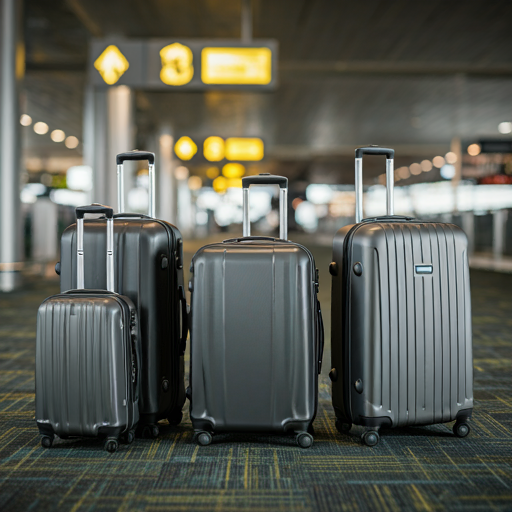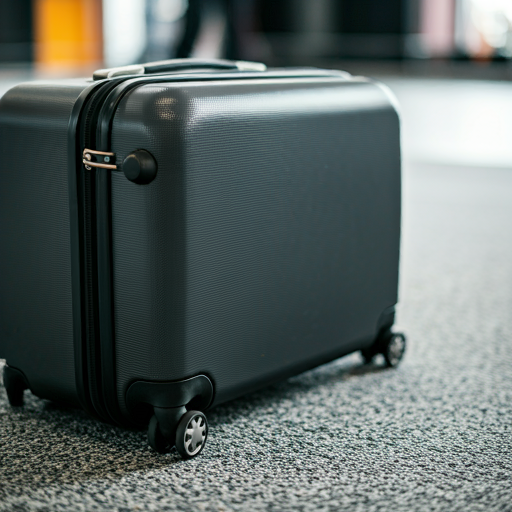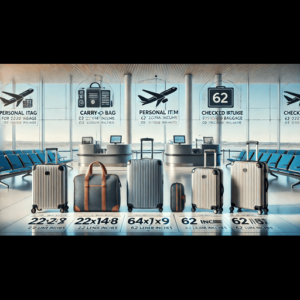When traveling internationally, knowing the size for international carry on luggage is essential for a smooth, stress-free experience. Airlines, both domestic and international, have varying regulations regarding the size and weight of carry-on bags, and what’s acceptable on one carrier may not fly on another. Most major airlines agree on a standard carry-on luggage size, of 22 x 8 inches or 14 x 9 inches. This dimension is generally considered the maximum size for a bag to fit comfortably in the overhead bin on most airlines, but it is also important to consider the policies regarding checked bags.
Table of Contents
However, not all airlines adhere to this same standard for luggage allowance. Some, quite a few airlines, particularly international carriers like Qatar Airways, set stricter limits. Qatar Airways, for example, only allows a maximum carry-on length of 20 inches. This difference in luggage allowance can catch even the most seasoned travelers by surprise. To avoid being held up at the gate or being asked to check your carry-on unexpectedly, it’s critical to check the baggage policy of your airline before you pack.
In addition to size limits, some airlines impose weight restrictions for bring carry on luggage. While many domestic flights do not enforce a strict weight limit for your own carry on baggage or luggage weight–ons, international airlines are more likely to. These restrictions can significantly impact your packing strategy, especially for long-haul flights where you’ll be tempted to pack more. Understanding the implications of checked bags in relation to carry-on luggage can help you avoid extra fees and potential damage or loss of belongings.
To ensure a smooth departure, always double-check the carry-on baggage size and weight restrictions of the airline you’ll be flying with. By doing so, you’ll avoid the inconvenience of having to check your bag and deal with extra charges or delays.
Understanding Carry-On Luggage Sizes
Understanding carry-on luggage sizes is crucial to avoid any issues during your flight. The standard size for carry-on luggage varies by airline, but most domestic flights typically allow approximately 22 x 14 x 9 inches for small cabin bags. International flights often adhere to slightly smaller dimensions of around 21.7 x 15.7 or 21.5 x 15.5 or 9 inches. These dimensions ensure that your carry-on fits comfortably in the overhead bin or under the seat in front of you.
It’s essential to check the individual airline’s policies before traveling to ensure your carry-on luggage fits their specific guidelines. Some airlines may have slightly different size requirements, and being aware of these can save you from the hassle of having to check your bag at the last minute. Always measure your carry-on, including wheels and handles, to ensure it meets the airline’s size restrictions.

Measuring Your Carry-On Bag
Accurate measurement is key to complying with your airline’s carry-on luggage size and requirements. It is also important to measure personal items like a laptop bag to ensure they meet airline regulations. A miscalculation could lead to an unexpected check-in situation, so it’s important to measure your bag carefully. Grab a tape measure or ruler, and carefully record your carry on luggage part’s length, width, and height. Be sure to include the wheels and handles, which are often overlooked but can add several inches to your bag’s overall carry on luggage size. When you’re packing for your next trip, make sure these components are part of the measurements, as they may push you over the airline’s restrictions.
| Airline | Maximum Size for International Carry On | Skateboard Policy | Reference |
|---|---|---|---|
| American Airlines | 22 x 14 x 9 inches (56 x 36 x 23 cm) | Non-motorized skateboards allowed as checked baggage. No electric skateboards allowed. | American Airlines Baggage Policy |
| Delta Airlines | 22 x 14 x 9 inches (56 x 35 x 23 cm) | Non-electric skateboards allowed as checked baggage. Electric skateboards and items with lithium batteries prohibited. | Delta Baggage Policy |
| United Airlines | 22 x 14 x 9 inches (56 x 35 x 23 cm) | Non-motorized skateboards allowed as carry-on if they fit size restrictions. Otherwise, they may be checked. | United Airlines Baggage Policy |
| British Airways | 22 x 18 x 10 inches (56 x 45 x 25 cm) | Non-electric skateboards allowed as checked baggage. No electric skateboards allowed. | British Airways Baggage Policy |
| Air France | 21.5 x 13.5 x 9 inches (55 x 35 x 25 cm) | Non-electric skateboards allowed as checked baggage. No electric skateboards allowed. | Air France Baggage Policy |
| Lufthansa | 21.7 x 15.7 x 9 inches (55 x 40 x 23 cm) | Non-electric skateboards allowed as checked baggage. No electric skateboards allowed. | Lufthansa Baggage Policy |
| Emirates | 22 x 14 x 9 inches (55 x 35 x 25 cm) | Non-electric skateboards allowed as checked baggage. No electric skateboards allowed. | Emirates Baggage Policy |
| Qatar Airways | 22 x 14 x 9 inches (55 x 35 x 25 cm) | Non-electric skateboards allowed as checked baggage. No electric skateboards allowed. | Qatar Airways Baggage Policy |
| Southwest Airlines | Not specified (carry-on fit under the seat) | Non-electric skateboards allowed as carry-on, must fit under the seat. Overhead bin storage allowed if wheels face up. | Southwest Airlines Baggage Policy |
| Hawaiian Airlines | Not specified | Non-electric skateboards allowed as checked baggage only. Must adhere to size and weight limits. | Hawaiian Airlines Baggage Policy |
| Allegiant Air | Not specified | Non-electric skateboards allowed as checked baggage. Not permitted as carry-on. | Allegiant Air Baggage Policy |
| Frontier Airlines | Not specified | Non-electric skateboards allowed as checked baggage only. Not allowed as carry-on. | Frontier Airlines Baggage Policy |
After measuring your checked bag amount, cross-reference your results with the specific carry on luggage size limits of your airline. It’s important to keep in mind that each airline may have different carry on luggage size criteria, and these limits might also vary depending on the route or class of service. By doing this extra step, you’ll save yourself from the surprise of an oversized carry-on bag or laptop bag at the boarding gate.
Additionally, some airlines use the linear inch measurement, which is the sum of your bag’s length, width, and height. Many carriers use this measurement as a guideline for whether your bag qualifies as a carry-on. If the total is within the limit, your bag will likely be accepted without issue by most domestic airlines, the most major domestic airlines anyway.
Airline-Approved Size for International Carry On
Understanding the specific carry-on luggage size limits for your airline can help you avoid confusion and potential delays during your trip. Most major domestic airlines allow you to bring one full-sized carry-on and one personal item. This flexibility means you can bring your larger carry on bag fits side-on for the overhead bin and a smaller bag—like a laptop bag or purse—under the seat in front of you. This is particularly useful for keeping important items within easy reach during the flight.
For example, Southwest Airlines has distinct size limits for carry-ons and personal items. They allow a carry-on with dimensions of 24 x 16 x 10 inches for the overhead bin and a personal item measuring 16 1/4 x 8 inches and 13 1/2 x 8 inches. International airlines, on the other hand, may impose slightly smaller restrictions one carry on bag, due to the smaller overhead bins on their aircraft. Singapore Airlines, for instance, has a carry-on size limit of 21 15.5 x, 15.5 x 9 inches.
Be sure to check your airline’s baggage policies, especially if you’re flying internationally. Policies can vary not only by the airline but also by the class of service or route. Budget airlines, for example, often enforce stricter size limits compared to premium carriers, which may allow for more lenient carry-on sizes. Knowing these details ahead of time helps you avoid unexpected fees or the headache of checking your full international carry on size, small cabin bag or on size full-on bag when you don’t need to.
Airline-Specific Carry-On Policies
Different airlines have specific carry-on policies, and it’s crucial to be aware of these policies before traveling. For instance, a 24-inch bag can be used as a carry-on suitcase with certain airlines like Frontier, Southwest, and Sun Country. However, other airlines have smaller carry-on luggage size restrictions, such as 21 15.5 x or 15.5 x 9 inches for international flights.
Some international airlines also have weight restrictions for carry-on luggage, while others do not. For example, Singapore Airlines enforces a carry-on weight limit that can range from 15 to 50 pounds depending on the class of service and flight route. On the other hand, many domestic airlines like American Airlines and Delta do not have specific weight limits for carry-ons, as long as the bag fits in the sizer.
It’s essential to check the individual airline’s policies before traveling to avoid any issues. Knowing these details ahead of time helps you avoid unexpected fees or the headache of checking your carry-on when you don’t need to.
Choosing the Right Carry-On Luggage
The perfect carry-on luggage does more than simply fit within size regulations. The ideal carry on items bag should also be practical, lightweight, and functional. When selecting a top carry on luggage allowance full-on diaper bag, you need to balance factors such as size, weight, and features to ensure it serves your travel needs. Additionally, choosing a laptop bag that fits airline regulations is crucial for maintaining organization and ensuring it fits under the seat.
For those seeking durability and protection, hard-shell luggage is a strong contender. It offers superior protection against impacts and is typically more resistant to rough handling by airport staff. On the other hand, soft-shell luggage offers flexibility, with the added benefit of expandable compartments for more packing space and quick access to essentials. Many soft-shell bags also feature external pockets that make it easy to retrieve items without rummaging through your entire bag.
Another key consideration is the weight of the carry-on. Some airlines impose strict weight limits one carry on only, and exceeding them can result in added fees or the need to check your bag. Lightweight luggage made from materials like polycarbonate or nylon can help you carry on luggage allowance stay within these limits. Additionally, bags with multiple compartments or organizational features can help you keep your items neatly packed and easily accessible.
Carry-On Weight Limits
While many airlines do not impose strict weight limits on carry-on luggage, some do, particularly on international flights. It’s important to note that the weight of a laptop bag is often included in the full carry on luggage weight take-on weight limit. For instance, low-cost airlines like Frontier and some Sun Country airlines have carry-on weight limits of around 35 pounds, which is significantly stricter than what you might find on domestic carriers. Singapore Airlines, meanwhile, enforces a full carry on luggage weight limit that can range from 15 to 50 pounds depending on the class of service and flight route.
| Airline | Weight Limit |
|---|---|
| American Airlines | No specific weight limit for carry-on (must fit in the sizer) |
| Delta Airlines | No specific weight limit for carry-on (must fit in the sizer) |
| United Airlines | No specific weight limit for carry-on (must fit in the sizer) |
| British Airways | No specific weight limit for carry-on (must fit in the sizer) |
| Air France | 26 lbs (12 kg) |
| Lufthansa | 17.6 lbs (8 kg) |
| Emirates | 15 lbs (7 kg) |
| Qatar Airways | 15 lbs (7 kg) |
| Southwest Airlines | No specific weight limit for carry-on (must fit in the sizer) |
| Hawaiian Airlines | No specific weight limit for carry-on (must fit in the sizer) |
| Allegiant Air | No specific weight limit for carry-on (must fit in the sizer) |
| Frontier Airlines | No specific weight limit for carry-on (must fit in the sizer) |
To avoid issues at the airport, it’s important to weigh your bag before heading to the airport. Many airports have free or low-cost luggage scales, or you can purchase a portable scale for at-home use. Knowing the weight of your bag ahead of time ensures you stay within the airline’s guidelines and can help avoid unexpected fees. Consider using vacuum-seal bags to reduce the bulk of your clothes and maximize space while keeping your bag light.
Personal Items vs. Carry-On Luggage
When flying, your personal item is just as important as your full carry on suitcase take-on, but they serve different purposes. Personal items are smaller and must fit under the seat in front of you. These items are essential for easy access during your flight and often include things like travel documents, snacks, medication, and electronics. Unlike your carry on luggage allowance take-on luggage, personal items don’t need to be packed for extended periods, but they must be small enough to fit under the seat in front you.
Common examples of personal carry on items include handbags, laptop bags, small backpacks, and compact totes. Airlines often have carry on policies that have specific size restrictions for these items, such as 16-18 inches in length, 14-15 inches in width, and 7-9 inches in depth. It’s important to review your airline’s guidelines before you pack your camera bag, as exceeding these limits can result in your personal item being rejected or forcing you to check it.
Prohibited Items in Carry-On Bags
Before packing, be sure to familiarize yourself with prohibited items to avoid delays at the security checkpoint. Carry-on bags are subject to strict security regulations, and certain items are strictly forbidden, including weapons, sharp objects, and flammable materials. Items such as knives, firearms, and large sporting equipment will likely be confiscated at the security checkpoint, so it’s essential to pack only what is allowed.
Additionally, the Transportation Security Administration (TSA) restricts the amount of liquids you can in one carry on bag with in your carry-on bag. The 3-1-1 rule allows for liquids, gels, and aerosols in containers of 3.4 ounces (100 milliliters) or less, all of which must fit into a single quart-sized, clear, resealable bag. Exceptions are made for medication, baby formula, and food, but these must be declared during security screening.
Efficient Packing Tips
Packing efficiently can be the key to a stress-free travel experience. Consider tips for packing a laptop bag, such as using accessible compartments for essentials and ensuring it fits under the seat according to airline regulations. By organizing your carry-on and personal items wisely, you can make the most of your space and ensure that you’re prepared for any situation during your trip.
Use packing cubes or compression bags to organize your clothing and maximize space. Separate your toiletries and electronics into smaller pouches for quick access. Roll your clothes instead of folding them to save room and reduce wrinkles. By packing thoughtfully, you’ll be able to stay within size and weight limits while keeping your items organized and accessible.
Tips for Traveling with Carry-On Bags
Traveling with carry-on bags can be convenient, but it requires some planning and preparation. Here are some tips to help you travel efficiently with carry-on bags:
Pack light: Try to pack only the essentials in your carry-on bag to avoid any issues during the flight. This not only helps you stay within size and weight limits but also makes it easier to manage your luggage.
Choose the right bag: Select a carry-on bag that fits the airline’s size restrictions and has multiple compartments to keep your belongings organized. Look for features like expandable sections and external pockets for added convenience.
Use packing cubes: Packing cubes can help you pack more efficiently and keep your belongings organized. They allow you to separate different types of items and make it easier to find what you need without unpacking your entire bag.
Wear bulky items: Consider wearing bulky items like your coat or boots to save space in your carry-on bag. This can free up valuable space for other essentials and help you stay within weight limits.
Keep valuables with you: Keep your valuables like your passport, phone, and wallet with you at all times. Store them in a secure, easily accessible part of your carry-on or personal item to ensure they are safe and within reach.
By following these tips, you can travel efficiently with carry-on bags and avoid any issues during your flight. Proper planning and organization can make your travel experience smoother and more enjoyable.
Common Carry-On Luggage Mistakes
One of the most common mistakes travelers make is failing to check the specific carry-on size restrictions for their airline. Not all airlines have the same regulations, and failing to measure your bag can result in an unexpected need to check it. Another common error is overpacking. It’s easy to get carried away, but overloading your carry-on can lead to weight issues, causing delays or additional fees. Additionally, many travelers overlook the importance of properly packing a laptop bag, which can serve as a personal item and help maintain organization with accessible compartments for essentials. Always measure your bag, check your airline’s guidelines, and pack thoughtfully to avoid these missteps.
By following these guidelines and being aware of size, weight, and personal item and restrictions, you’ll be well on your way to a smooth and hassle-free travel experience.










